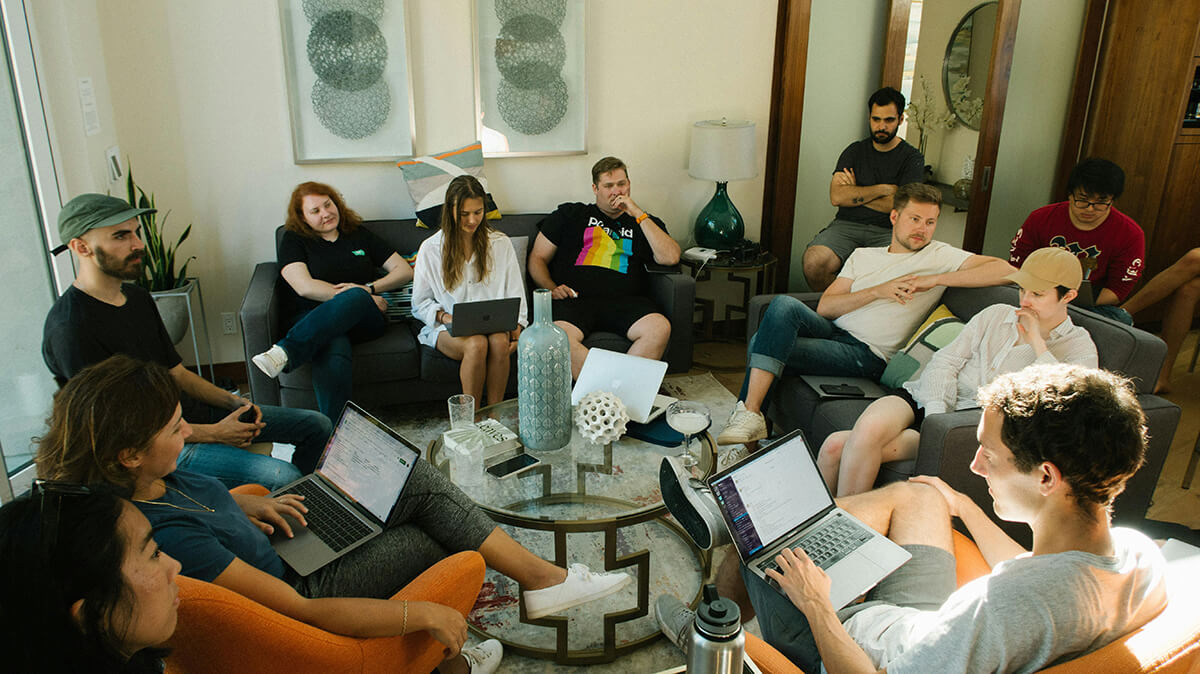Employee communities aren’t just connection and inclusion initiatives. They’re strategic business units that have a direct impact on your bottom line.
With the right strategy and structure, employee communities like people resource groups , business resource groups, affinity groups and other employee networks boost profitability, foster innovation and increase retention. These communities don’t just enhance company culture but drive real financial returns. We have the data to prove it.
Defining Employee Communities and Their Examples
Community is an essential structure–if not the essential structure–of civilization. Humans are social creatures who are dependent on one another for survival. Organizing into communities allows us to harness collective power in order to reach a common goal.
Employee communities are workplace networks organized around a goal, characteristic or identity. These groups can be formal or informal, centralized or distributed, in-person or remote. Regardless of their structure, employee communities pay big dividends for internal employee community members and the larger corporate organizations they serve.
The rewards of resources and groups for employees include a support system, a sense of belonging and a more positive workplace culture. But there are more tangible benefits to building a workplace community too. Quantifiable benefits of employee communities include increased employee engagement, retention, productivity, profitability and innovation:
- Deloitte’s research shows that retention improves when employees have the right kind of community support. Specifically, millennials who have mentors at their organization are twice as likely to say that they plan to stay at least five years (68% vs. 32%).
- Employee communities such as ERGs boost inclusion and belonging efforts, which in turn boost profits. McKinsey data shows that orgs with leadership teams in the top quartile for gender diversity are 25% more likely to have above-average profits than those in the bottom quartile.
- The same research shows that companies with more ethnically diverse leadership teams were 35% more likely to have above-average profits than less diverse teams.
- Research shows employee communities pay off in terms of innovation, as well. Psychology Today cites examples like “an American multinational technology company’s ERGs creating a textured hair care essentials website for beauty and hair products for people of color, and another organization’s Hispanic/Latino ERG creating different varieties of snack foods.”
4 Types of Employee Communities
Employee communities come in many forms, each serving a unique purpose in fostering connection, support, and engagement. Understanding the different types can help organizations create spaces where every employee feels seen, heard, and valued.
Employee Resource Groups (ERGs)
Perhaps the best-known type of internal employee community is ERGs. These communities are based on shared interests, such as supporting parents, promoting mental health, veteran status or advocating for women. Alternatively, ERGs may focus on identity, such as LGBTQ+, ethnic or race identity, or career stage.
Crucially, ERGs have a business focus: the goals of the group are typically tied to the goals of the business unit or organization.
ERGs are similar to other employee communities, including affinity groups, business resource groups or employee-led groups, and the terms are sometimes used interchangeably. However, there are distinctions, which we’ll get into later in this piece.
Employee communities may develop organically as grassroots organizations or begin with corporate sponsorship.
Communities of Practice
The term communities of practice (CoP) was coined by Dr. Jean Lave and Dr. Etienne Wenger-Trayner to describe groups organized around a shared concern or competency. These groups interact regularly to engage in knowledge sharing, solve problems and develop best practices.
Communities of practice have a variety of practical applications that contribute directly to an organization’s bottom lines. In an article at Harvard Business Review, Wenger-Traynor and his colleague William M. Snyder, a founding partner of Social Capital Group, offer several case studies demonstrating how communities of practice can lead to new product lines, improved problem-solving and reduced R&D cycles.
Learning Communities
Learning communities are groups focused on continuous learning and skills development. These employee groups may take the form of mentorship programs or skills-based instruction in a peer environment.
Typically, these groups aim to share knowledge, create support networks or strengthen the leadership pipeline by identifying and retaining high-potential employees, meaning team members with the motivation and drive to succeed in senior roles or other mission-critical positions. For example, your organization might use learning communities to upskill talented, highly engaged employees to help them move into key technical roles or leadership positions.
Interest-Based Groups
Not every internal community has an obvious link to the company’s financial goals–but don’t be surprised if you see improvements in employee engagement, productivity, and retention as a result. And what about employee fulfillment? Interest-based groups organized around shared hobbies can pay big dividends in terms of inclusion, morale and team building.
Interest-based groups can be organized around almost any pursuit from running and yoga to reading and crafting. Consider looking into building communities based on volunteering, as well; studies have shown that volunteering empowers employees and makes them happier at work, which in turn boosts productivity.
Best of all, you’re likely to find enthusiastic sponsors among devotees who would jump at the chance to bring more of their authentic selves to work.
Employee Community Types, Terminology and Differentiation
Workplace community types can be broken down by purpose, company goal, personal identity or professional role.
Types and Classifications:
These are a few of the most common types of employee communities and how they’re classified:
Employee Resource Groups
ERGs are the gold standard of employee communities and for a good reason. These groups typically have a clear tie to business goals as well as important community benefits like professional development.
Affinity Groups
While ERGs are tied to business goals, affinity groups are tied to personal identity. A company might have affinity groups for any kind of identity you can think of, from innate (race, ethnicity, culture) to acquired (parenthood, military service).
Skills-Based Groups
The best teachers are those with hands-on experience and your organization likely has plenty among its ranks already. Skills-based groups, whether they take the form of mentoring or instruction, can help support knowledge transfer from experienced employees.
Mentoring
There are as many kinds of mentoring programs as there are opportunities for improvement and connection. Consider group mentoring, one-on-one mentoring and reverse mentoring for knowledge sharing.
Leadership
Whether you’re getting new-to-you leaders up to speed on the company culture or deepening your future pool of high-potential managers, leadership mentoring can help you maximize opportunities.
Nomenclature and Key Differences
Employee community terminology can be tricky. Organizations have their own internal nomenclature, and many terms can overlap. However, there are a few key differences to keep in mind:
ERGs vs. Affinity Groups
While ERGs typically have a direct connection to company goals, affinity groups are often more informal. Affinity groups may be employee-led and lack corporate sponsorship.
ERGs vs. BRGs
Business resource groups (BRGs) are even more tightly tied to business goals than ERGs. Often, BRGs have direct executive sponsorship and goals that drive the bottom line.
Other Related Terms
Beyond ERGs, BRGs, and affinity groups, there are several other types of employee communities that may come across your radar. These include employee networks, diversity networks, resource groups, associate resource groups and communities at work.
The nomenclature is less important than the structure and purpose. To build a strong internal community, you will need to start by deciding what the group is supposed to achieve, whether it will be volunteer-led and/or have executive sponsorship and how to measure success.
Building and Fostering Employee Communities
When it comes to building employee communities, you have two options: organic growth or intentional creation. For example, many affinity groups may arise spontaneously from employee interest and be led by a staff volunteer. In contrast, a BRG may come from the leadership team and be tied closely to business goals.
Whichever type of internal community you choose to foster, your strategy should be tied to concrete goals, include metrics for success, and come with a way for participants to deliver feedback. If you choose employee community software to manage your program, look for strong employee community platform features like robust matching capabilities, HRIS integrations and automated nudges to participants.
Here are a few employee network best practices, plus step-by-step methods for initiating, sustaining and nurturing internal communities to ensure long-term employee engagement and value:
- Affinity groups: Define your goals, assemble resources, secure leadership buy-in and recruit workplace community members. Prepare a strong mission statement outlining your purpose and the benefits of the program. Be prepared for pushback from leadership and members and be open to receiving feedback.
- ERGs: Begin with a clearly defined mission and measurable objectives. ERGs are often more tied to organizational goals, so be sure that you can demonstrate success. Build in mentoring and flexibility to ensure that you can adapt your program as needed.
Best Practices, Toolkits and Data-Driven Insights
Overview:
Chronus offers a free ERG toolkit that can help organizations begin the process of defining objectives for their ERGs. A few best practices for building successful ERGs include:
- Setting clear goals
- Measuring strategic objectives
- Obtaining executive sponsorship
- Creating an inclusive environment
- Developing a feedback process
Examples of Employee Communities
Given the data showing that employee communities support profitability and innovation, it’s no surprise that they’re popular with the most successful businesses. In fact, 90% of Fortune 500 companies have enterprise employee communities like ERGs, according to McKinsey.
Microsoft
The company runs nine ERGs including Asians at Microsoft, Blacks at Microsoft, Disability at Microsoft, Women at Microsoft, the Families ERG and the Military ERG. Some of these communities have been around for a while; Women at Microsoft will celebrate its 35th anniversary in 2025.
ERGs don’t just create a culture of inclusion at Microsoft; they also drive innovation. As an example, the company points to Copilot, “which helps developers with physical disabilities to code without barriers.
Amazon
It launched its Amazon Mentoring Program (AMP) in 2016. In partnership with Chronus, Amazon has grown its program by 750%, scaling up from 18,800 users to over 160,000 employees. AMP now supports more than 100 programs targeted at leadership development, high-potential employees and mentoring circles for affinity groups.
Paychex
As a provider of integrated human capital management solutions for payroll, HR, retirement, and insurance services, Paycheck partnered with Chronus to create a Women in Leadership (WIL) initiative to build a stronger leadership pipeline. Participants in the program had a 94% retention rate, which was 14% higher than the organization’s rate as a whole.
Wrap-Up: What Can Employee Communities Bring to the Table in Your Organization?
Employee communities drive business results including increased profits and innovation, as well as improved employee retention and productivity.
Every org is different and has different needs, but the framework provided in this article will help you set your strategic objectives, decide on business outcomes to measure, and gain the executive buy-in you need to make your project a success.
Chronus has helped 3 million people at some of the world’s largest organizations unlock the full potential of their workforce. Find out how we can help you build employee communities that achieve your goals. Get started with a demo!




